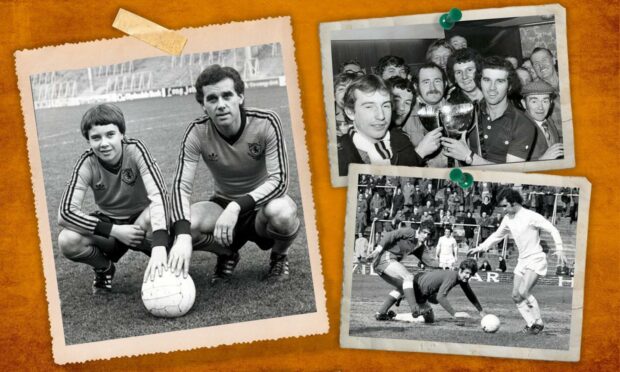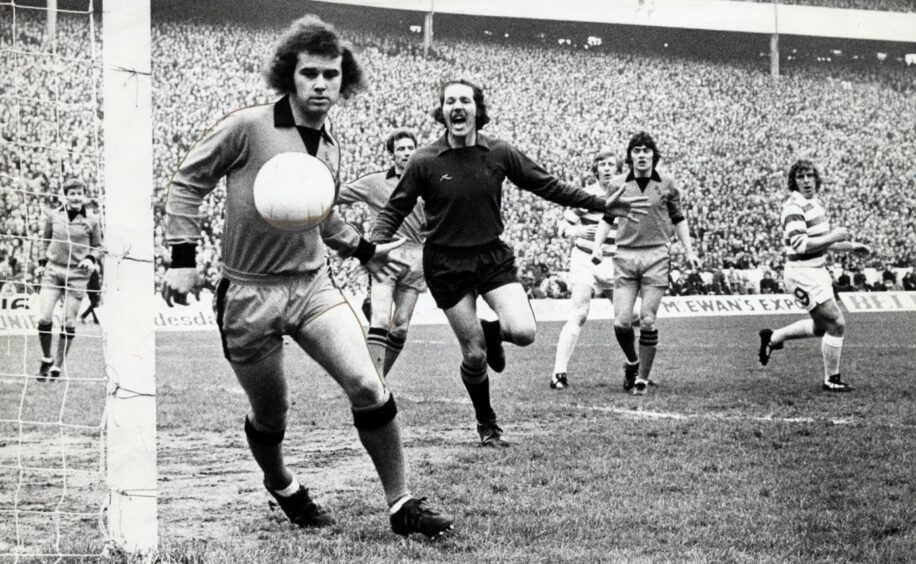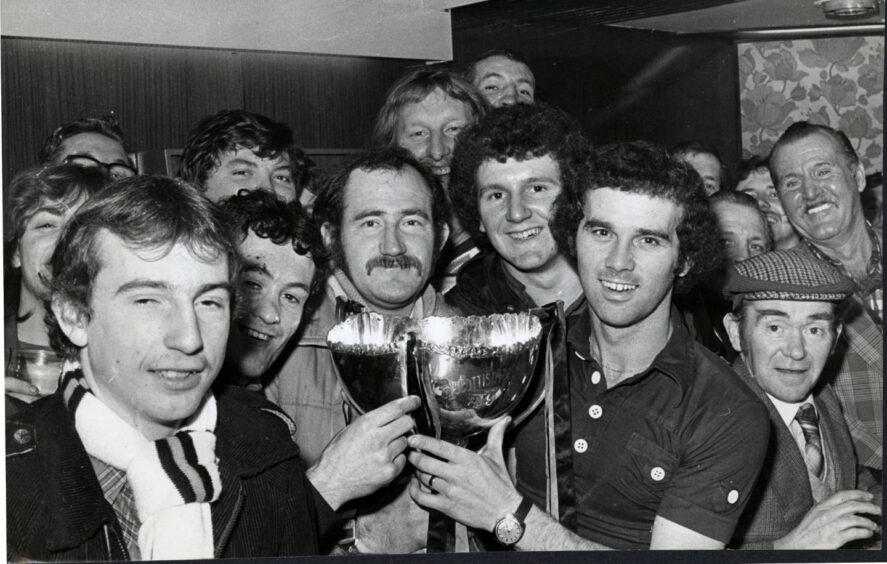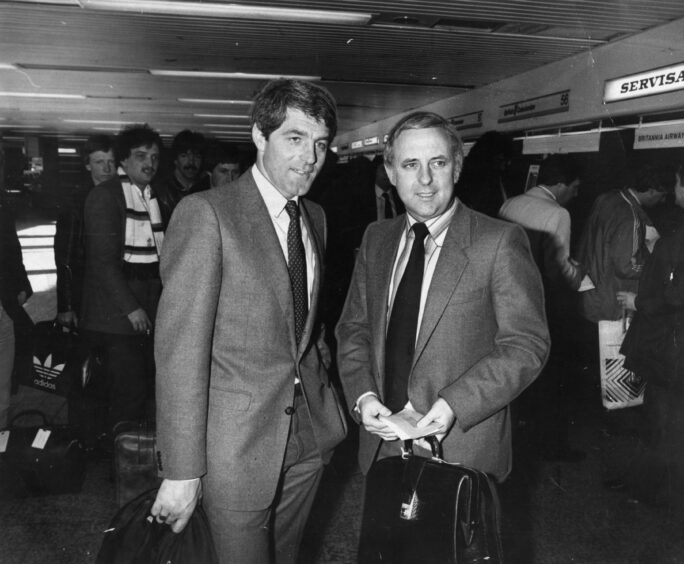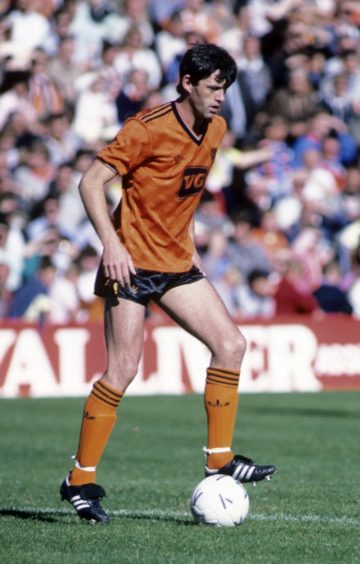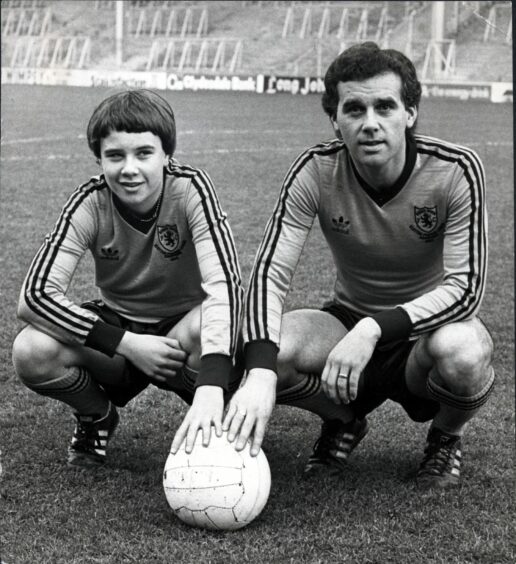Frank Kopel was at a crossroads in his career when he received a Hogmanay phone call 50 years ago from Jim McLean that would change his life.
The Falkirk-born left-back started his playing career in 1964 under Sir Matt Busby at Manchester United before signing for Blackburn Rovers for £25,000 in 1969.
Things didn’t work out and he managed just 25 appearances for Blackburn before being released in December 1971.
McLean was just weeks into his tenure as Dundee United manager when he made him an offer to join his Tannadice revolution.
He immediately packed his bags and drove to Scotland with wife Amanda.
They stayed overnight in Falkirk and went to Muirton Park on New Year’s Day where United were playing St Johnstone and Frank became McLean’s first signing.
The rest is history
Frank went on to make 407 appearances during a 10-year spell under McLean and won back-to-back League Cups in 1979 and 1980.
The pair went on to form an incredible bond and became lifelong friends.
Pat Kelly – author of the book Dundee United Who’s Who – sat down with Frank to chat about his career in 2008 for the club’s official Tangerine and Black magazine.
The wide-ranging chat would be his last full interview about his career before he started to struggle to remember his past glories on the football pitch.
Frank was diagnosed with dementia aged 59 and Amanda and son Scott were by his side when he passed away aged 65 in April 2014 at his home in Kirriemuir.
The 2008 interview can be published today in tribute to the man who made history as the first-ever signing in McLean’s triumphant 22-year Tannadice reign.
Pat started by asking Frank when he started playing football?
“Like most young lads I started whilst at school,” he said.
“From there I progressed to train with Falkirk youth players and I trained a couple of nights a week at Brockville.
“I was given the opportunity to play for the Scotland Schoolboys and then I was spotted by Manchester United.
“They asked if I wanted to go for a trial with them.
“This was in 1964 and I thought it was as easy as that – you just got picked up by a club.
“In April 1964, I was lucky enough to be taken on as an apprentice by Manchester United.
“At Old Trafford at that time you had four teams and you had to try and progress through the ranks, through to the first team.
“I was five years in total down at Old Trafford and was fortunate enough to be involved with the Manchester United first team.
“I also managed to get a European game under my belt the year after they won the European Cup in 1968, and prior to that I managed to get two or three first team games under my belt.
“In fact I played nine first team games in total and one as sub.”
What was it like having George Best, Bobby Charlton and Denis Law for team-mates?
“I never really thought that much about it to be honest,” he said.
“It was certainly a fair old mix down there.
“I sometimes trained with other squads as well.
“Manchester United had four teams in those days so I didn’t always see those legends every day.
“Some would go with the A team whilst others would go with the B team – it varied from day to day.
“Young players like me were just part and parcel of the club – that’s what it was like in those days.
“However, looking back it was a wonderful experience for me to be involved in such a big club.”
Did the Holy Trinity of Best, Charlton and Law stand out in training?
“Without a doubt – they were a different class and quality,” said Frank.
“Manchester United had to rebuild after the Munich disaster in the 1950s and these players were of such high standard that it would take your breath away.”
Pat asked Frank what Sir Matt Busby was like to have as a manager?
“He was like a father figure and you always knew it was him when he walked in the room,” he said.
“As far as tactics were concerned it didn’t really figure highly with him.
“It was fairly plain and simple and I cannot recall him ever telling a player that you have to do this or do that – we just basically went out and played.
“If we were under pressure I recall him just pushing us slightly up the park.
“I was learning all the time under Sir Matt without really realising it.
“From there I signed for Blackburn Rovers in 1969 and I stayed with them for two years before Jim McLean asked if I would like to sign for Dundee United.
“I did and I was very fortunate to share in the some of the club’s major successes.”
What was Frank’s favourite European game with Dundee United?
“Without a doubt it has to be the game against Anderlecht,” he said.
“It was also when I scored one of those once in a lifetime goals – your eyes are closed – you hit the ball – and it hits the back of the net!
“Even now people still talk to me about that great goal I scored against Anderlecht.
“Funny enough I played over 300 games for Dundee United and yet that’s the one thing most Dundee United fans remember about my playing career here at Tannadice.
“Many other players are in the same boat – not that I’m complaining you understand it’s just that it is nice to be remembered for something!”
Frank’s stunning late strike in a 1979 Uefa Cup tie against the Belgian club took the Tangerines into the next round on the away goals rule.
United fans nicknamed him the ‘Arrow in Anderlecht’ while Scotland manager Jock Stein chose it as his goal of the season that year.
Pat asked Frank what Jim McLean was really like as a manager?
“Tactically and coaching wise he was very in-depth,” said Frank.
“As far as coaching was concerned he was brilliant.
“Jim really made you think about the game and his tactics were excellent and always spot on.
“When you consider the number of ex-Dundee United players that became good managers in their own right, then you soon realise that this was all down to the grounding given to players by Jim McLean.”
Was McLean ahead of his time with regards to his coaching and tactics?
“I would say you are absolutely correct with that assumption – Jim brought through and coached some fabulous players like Paul Sturrock, Dave Narey, Maurice Malpas, Paul Hegarty and many others,” said Frank.
“Without a doubt this was all down to Jim McLean and his coaching ability.
“He brought the best out in players.”
Frank was asked to name the best player he saw wearing a United shirt?
“I think it would have to be Davie Narey,” he said.
“However, Paul Hegarty was also exceptional, but again it is just too difficult to answer because I was fortunate enough to play with some wonderful players here at Tannadice.
“The team spirit at the club at that time was phenomenal.
“It was just like some of your old classmates from school.
“We were all very close to each other and on the park we were all fighting for each other.”
Great memories
Frank left United in 1982 just before the club won the league title in 1983.
“It was hard to leave such a great club but then I knew it would happen at some point – so I took up a coaching post with Arbroath,” he said.
“I was down at Gayfield for a couple of years.
“Paul Hegarty was managing Forfar and I left Arbroath to join him at Station Park.”
Pat concluded by asking Frank how the game had changed since he was a player?
“Two teams run the show in Scotland which is not really healthy for the game but that’s always been the case I suppose,” he said.
“Football is always changing and I have some great memories of my playing career and not forgetting my time here at Tannadice.”
The final word goes to Pat Kelly who spoke to Frank back in 2008.
“For a man in his early 60s to be struck down with such a debilitating disease makes it all the harder to understand but it was a pleasure to talk to Frank in 2008,” he said.
“He was an absolute gentleman, a very kind man, and will always be truly loved by all who knew him.”
More like this:
Dundee United legend Jim McLean: A football life in pictures
Never-before-seen photos of Dundee United fans in Gothenburg in 1987
Rangers broke Dundee United legend Jim McLean’s heart in forgotten ‘family final’
